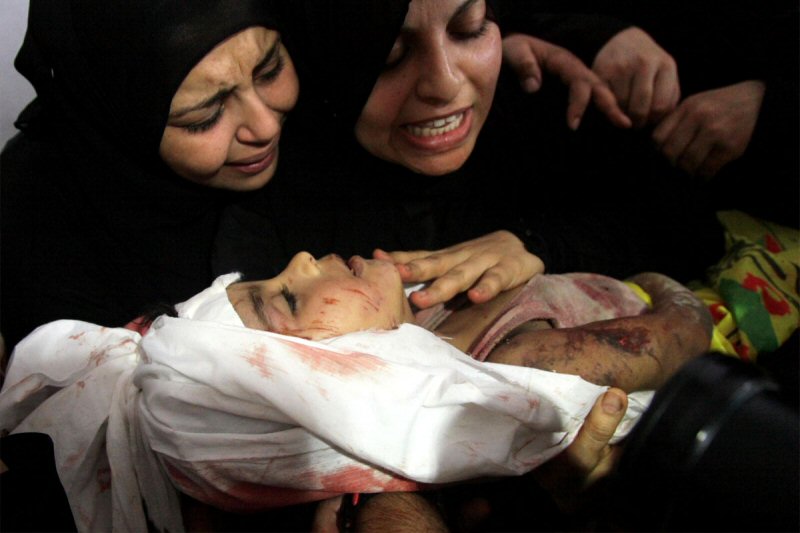Israeli forces injured and detained Palestinian children in higher numbers, over the final weeks of 2017, as Israeli authorities used widespread force to quash sweeping protests across the Occupied Palestinian Territory (OPT).
Following the United States’ recognition of Jerusalem as Israel’s capital, Israeli forces misused crowd-control weapons and, at times, live ammunition against children in the context of confrontations with Palestinian protesters. Between December 6 and 20, Defense for Children International – Palestine documented eight child injuries in the OPT. Six of this number suffered head injuries, all except one with potentially irreversible damage, including two children with permanent eye loss. The number of children arriving at Israel’s Ofer military prison in the central West Bank also doubled this month, marking a spike in military detention in which systematic ill-treatment of Palestinian minors is routine.
“Excessive force and misuse of crowd control weapons has once again proved to be the norm for Israeli forces when quashing protests,” said Ayed Abu Eqtaish, Accountability Program director at DCIP. “Israeli forces seemingly disregard their own open-fire regulations and international law, and enjoy near complete impunity for their unlawful conduct. This lack of justice and accountability results in a high toll paid by Palestinian minors subjected to serious injury or even death.”
Widespread protests
U.S. President Donald Trump’s decision to publicly recognize Jerusalem as the capital of the Israeli state led to large-scale demonstrations, marches and clashes throughout the West Bank, including East Jerusalem, and the Gaza Strip. Israel annexed the eastern half of Jerusalem in 1967, a move condemned by the United Nations Security Council and not recognized by the international community, and is considered occupied territory under international law. The U.S. decision leaves future borders up for negotiation but reversed a long-held White House position of maintaining its embassy in Tel Aviv, saying the embassy would be moved in three years.
Palestinians called for several “days of rage” to demonstrate local opposition to the move. Protesters, including children, in some cases threw stones and firebombs, often near checkpoints and other Israeli military installations. Israel appears to have primarily relied on crowd-control weapons and rubber-coated metal bullets to quell protests with some incidents of live ammunition. DCIP documentation of injuries and witness reports however showed an alarming misuse of crowd-control weapons.
The United Nations General Assembly overwhelmingly voted on December 21 to reject the decision, days after the UN Security Council proposed a resolution to withdraw the U.S. recognition. With the exception of the U.S., which used its veto power to scrap the resolution, all of the 14 other members supported the measure.
Misuse of crowd-control weapons
In the West Bank, two Palestinian teenagers, both aged 15, were struck in the head by rubber-coated metal bullets at the hands of Israeli forces.
Qassam K., 15, was critically injured by a rubber-coated metal bullet according to initial DCIP interviews with the child’s father. The child’s father told DCIP that Israeli forces entered the northern West Bank city of Nablus around 1 a.m. on December 20 and shot the teen with a rubber-coated metal bullet during clashes, fracturing his skull.
An eyewitness told DCIP that Israeli forces shot Mohammad Tamimi, 15, with a rubber-coated metal bullet shortly after clashes had ended in the Ramallah-area village of Nabi Saleh in the central West Bank on December 15. According to the eyewitness, Israeli forces appeared to have exited the area around 4 p.m. when an Israeli soldier shot Mohammad in the face with a rubber-coated metal bullet at close range.

“He [Mohammad] was laying on the ground. His face and clothes were covered in blood,” the eyewitness, who wished to remain anonymous, said.
Mohammad’s treating physician told DCIP that the 15-year-old underwent two operations to remove the rubber-coated metal bullet, which lodged in the back of his skull and caused severe bleeding in his brain. The child’s 16-year-old cousin, Ahed Tamimi, was detained days later in a night raid.
In the Gaza Strip, two 14-year-old boys were hit in the face with tear gas canisters when Israeli forces stationed in a military watchtower opened fire on protesters near the Erez crossing.
“It hit me in the face like a stone.” Mohammad al-Farani told DCIP. “It was so painful, I don’t know how to describe it. There was a lot of blood running down my face.” The child was sitting on a concrete block at a December 11 protest near the Gaza border when a canister hit him in the face. He was treated for a fractured cheekbone, head gash, internal bleeding in the brain, and later underwent eye surgery to remove his right eye.
Nidal al-Majzoub was standing nearby and hit shortly after, requiring 10 stitches on his forehead. Both children were around 50 to 60 meters (55 to 65 yards) from the watchtower at the time of injury.
In November of 2017, the Palestinian Central Bureau of Statistics reported fourteen child deaths that had been documented since the beginning of the year and until the end of August.
Three children were in the age group 13-15 years and the other 11 were in the age group 16-17 years.
The death toll continues to rise, with the coming of the new year.
(photo: Days of Palestine.)
01/09/18 ICC to Open Full Investigation into Settlements, 2014 War on Gaza

